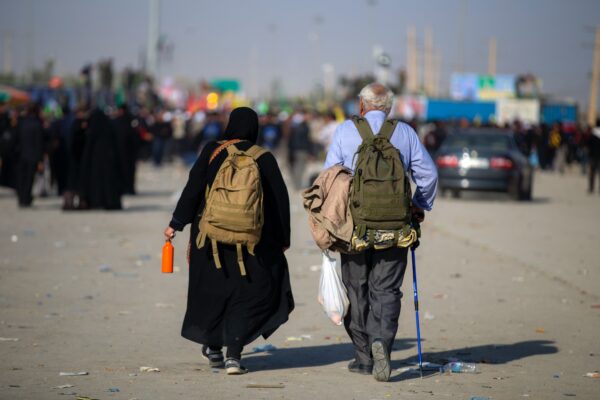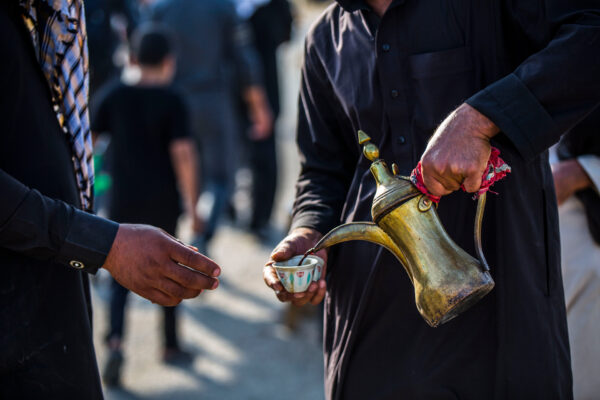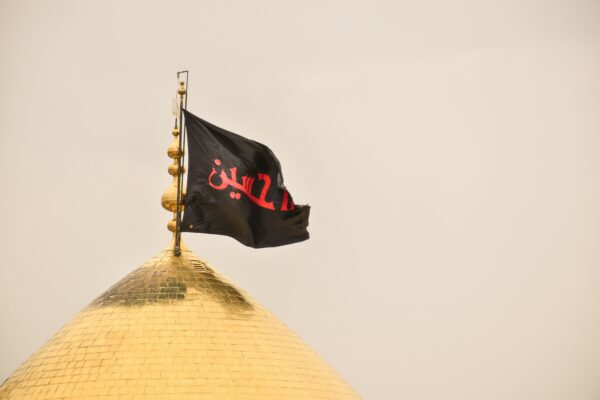She teaches us that we should never condition ourselves to the social climate of our time, rather we ought to condition ourselves to true Islam.
She teaches us that we should never condition ourselves to the social climate of our time, rather we ought to condition ourselves to true Islam.
Shaheeda Bint Al-Huda had every imaginable characteristic those in power deemed a threat and vehemently opposed: she was a female activist of the highest moral, spiritual, and religious caliber, who was afraid of none but Allah (swt) with a vision grounded in deep knowledge, awareness, and wisdom. To play the role that she played, in successfully publishing tens of books, establishing several religious schools, and raising her powerful voice on the Muslim women’s sufferings and erosion of Islamic values in her country when no one else was able to speak out makes her movement a significant one. She managed to penetrate a conservative and controversial environment at a time where the role of a woman was very limited. Her mere presence called for a revolution.
Shaheeda Amina Haider Al–Sadr (famously known as Bint Al–Huda – the daughter of guidance) was born in Kadhimiya, Iraq in 1937. From a very young age, she became an avid reader of religious books and modern works, allowing her to study the society and diagnose the ills of Muslim women in Iraq and the Islamic world, where she published articles from as young as 11. Despite the significant role her senior martyred brother, Ayatollah Muhammad-Baqir Al-Sadr played in building her personality, one cannot overlook her distinctive character, in which she was described to possess fiery intelligence, quick memorisation, and the ability to convince others since her childhood. Narrating her memories of childhood, she says, “When I was little, our financial condition was very poor, yet I had a daily allowance of ten fils. I used to save this modest amount of money every day, then go to the market to buy a book about Islam. I had a friend who used to do the same, and we therefore would read each other’s book once we finished with our own.”
Had she not been inherently distinct and full of ambition, she would not have benefited from her martyred brother as much; after all, how many sisters have religious authorities and great men surrounding them, yet they do not reach the leadership and station of sacrifice which Shaheeda Bint Al-Huda reached? We are speaking of a time where females, particularly those from religious families, were considered uneducated and were not encouraged to actively pursue knowledge and play an effective role in wider society; a time where Muslim women were suffering from backwardness, injustice, ignorance, and persecution.
From the onset, Shaheeda Bint Al-Huda managed to break through the stereotypes and barriers at a sensitive period of history, a time where the Iraqi field was dominated by two trends: the trend in degradation of moral values, and a traditional conventional ‘Islamic’ trend that demanded women sit at home, preventing them from communicating with men in society. In the middle of these two trends, she demanded Muslim women be able to rise and assume their responsibility in shifting away from these models that exist in society, empowering women with a major rather than a marginal role to play.
She teaches us that we should never condition ourselves to the social climate of our time, rather we ought to condition ourselves to true Islam, which seeks to promote the status of women through encouraging them to actively pursue education. It was her strong, deep-rooted knowledge of the Quran that framed her understanding of the role of a woman within society, whereby she notably used the Quran in support for female empowerment and defining a woman’s rights and responsibilities.
At a time where a woman’s voice was not represented nor respected, she soon became a voice for the voiceless. In her early 20’s, she began writing articles in Al-Adwa’ Islamic magazine that was printed by the high-ranking religious intellectuals of Najaf. Her writings for women were in a transparent and refreshingly different language, employing an attractive literary style that managed to attract women from different countries that could now find a way to understand Islamic thoughts.
British Photojournalist Emily Garthwaite Reflects on her Arbaeen Experience
In her foremost articles, Shaheeda Bint al-Huda starts by explaining what Islam expects of women, adding, “It wants women to learn so she may come to know the essence of Islam according to its magnificent reality, not to become familiar with the moral looseness of Western women and the close-mindedness of the Eastern ones. Islam wants her to be a torch of Divine light, while the corrupt society tries to turn her into a puff of fire. Islam wants her to be a fragrant flower, whereas the carnal concept wants her to become like a yellow withered leaf with the wind playing havoc with it. The Almighty created her to be the captain of the ship, but the false civilization has made her for quite some time a toy. He created her to be the school for the generations, but the forces of evil exert themselves to turn her into a dumb machine.”
She found the media field, then undertaken by clergymen and Islamic writers in need of an Islamic female pen that would address a huge amount of opposing and contending writings, responsible for pushing woman in the direction of aversion towards their Islamic values; for a man is not like a woman in his knowledge of woman’s conditions, concerns and thoughts. Her ability to eloquently articulate the concerns of the masses truly made her an influential woman that educated and uplifted, particularly Iraqi Shi’i women, to realise their true worth and potential, who otherwise did not feel empowered as they lacked the education and courage to express their sentiments in such a way.
It is certainly worth mentioning the great wisdom she possessed in conveying the Islamic viewpoint, particularly to the younger generation in a simple narrative; was that she authored dozens of fictional stories that were directly relevant to the struggles facing the women in Iraq, analogous to how the Holy Qur’an expresses the value and precepts of Islam through stories of Prophets and the recollection of their particularities. For example, she treated with extreme precision the issue of marriage, where the perfect spouse was perceived to be the one who has a large fortune or a prestigious degree, as well as the image of the ideal wife: one who possesses superior (albeit false) beauty. She depicts her as sitting hours and hours in beauty salons in order to conceal her true face. Labels for the problems of society which martyr Bint al-Huda addressed in her stories included: the suffering of working women, the ridiculing, distorting, beautifying, the applying of cosmetics and the wearing of the veil. Shaheeda Bint al-Huda delved into the world of writing and the media not to satisfy a personal desire for recognition or fame, or to be occupied by writing for the sake of writing; to her, multi-faceted Islamic work was a sacred duty rather than something marginal or secondary. She teaches us that our work ought to be a sacred act of worship.
Even though woman within scholarly families had a limited role within the religious institutions and generally in wider society at that time, Shaheeda Bint Al-Huda was a special case in that she was able to work effectively with the ulama. She played a significant role in strengthening the relationship between the religious authority and women, where she was a link in the transfer of concerns and aspirations, as well as their demands to the religious authority. Shaheed Sayyid Al-Sadr, in turn, supported these women in order to perpetuate their movement in society. She was even funded by religious authorities to establish four schools under the name of Al-Zahra school for girls in Najaf, all of which were under her supervision. The schools were not built to meet society’s need for schools; rather, she saw the establishment of these schools as the best means in the face of the materialistic culture that prevailed, whereby the daughters of many families – even scholarly and religious ones – used to remove their veils as soon as they entered their university campuses as it was widely viewed as ‘backward’ and generally unacceptable in the educational institutions.
These established schools scored a significant success rate in ministry exams among government schools, so much so that they became famous for their scholastic and educational reputation, and more people sought them to the extent that the classes could not accommodate all students. However, this case could not continue after the arrival to power of the Iraqi Baathi Party, which clashed with the trend of Islamic awareness led by Shaheed Muhammed-Baqir al-Sadr. The said Party took the initiative to close all Islamic institutions, including the Zahra Schools and persecuted all those who publicly promoted this Islamic line of thought.
Shaheeda Bint al-Huda took the lead in the women’s Islamic movement in Iraq and decided to go on Shaheed Baqir Al-Sadr’s (her brother) path in this regard. She was endowed with great wisdom and awareness, in having a high level of insight into the political, social and cultural climate of her time, and the role she had to play in society. When her brother was arrested because of his opposition to the government’s policies, Shaheeda Bint al-Huda showed strength and delivered a speech in the holy shrine of Imam Ali (as), telling the people that their religious authority was arrested. Her speech was so powerful it created shockwaves throughout the region- there were masses of demonstrations which took place all over Iraq, Iran, Lebanon, and Bahrain for the release of Shahid Al-Sadr. We are talking about a climate where if an individual was heard uttering the word ‘Dawah’ in public, they would be brutally executed in Saddam’s prisons. That was a time where the masses were fearful of even appearing religious in public, in fear of torture and death.
The security forces arrested her brother Shaheed Muhammad-Baqir Al-Sadr on the of 5th April 1980, and the next night they returned and arrested her. She said to the security officers upon arresting her, “it is a great honour that you have arrested me,” and continued, “you cowardly bullies who follow that which is vain and useless, if you had any courage at all you would have come in the light of the day and not in the middle of the night!” News of both their martyrdoms emerged on the 9th of April, whereby the dead bodies bore signs of brutal torture. The face and beard of Shaheed Al-Sadr were burned and charred, and there were stab wounds and bruises on many parts of his body. Shaheeda Bint Al-Huda’s hands were burnt and her scalp peeled, and the hands and feet of both were crushed and badly lacerated. To God we belong and to Him we shall return.
What is certainly worth pointing out was her unwavering courage and bravery, where even the bravest of men, with all their physical strength, would think twice about expressing sentiments against the brutal Ba’athi regime. As a woman, she could have made several excuses for herself, such as the fact this was a man’s job and isn’t compatible with the job of a woman, however the source of this courage and bravery, which led to her attaining the highest level of martyrdom, was most certainly the unshakable relationship she had cultivated with Allah (swt), such that the opinions of those around her and most certainly their reactions meant nothing to her.
Her soul was tranquil, like her ultimate role model Sayeda Zainab (sa), the granddaughter of the Prophet (saw), that submitted her affairs to her Lord during the advent of Karbala. Shaheeda Bint Al-Huda knew the savage nature of the regime she was facing, and she knew it would spare nobody and understood her stance posed a real threat to the Baathist regime and its allies, who foolishly thought just like Yazid did, that incarcerating and brutally executing her along with her family would weaken the revolutionary spirit of those following this line of resistance against the oppressors. But again, we find history repeating itself, and we find ourselves extending her legacy and in awe of such a personality that cultivated her relationship with Allah (swt), to the extent that her tranquil soul could see ‘nothing but beauty’.
She teaches us that we cannot go on to develop a clear vision and set of targets in mind without having a firm basis in Islamic education, in addition to an awareness of the environment around us as these two factors will dictate to us our social responsibilities. That is to say, Islam is at the heart of effective activism and the two cannot be decoupled.
She teaches that cultivating our relationship with Allah (swt) as firmly as possible is the only way for us to attain courage on this path of resistance, that even if the times appear bleak and dangerous, we will be shielded from this fear whereby only this relationship will give us the capacity to acquire perseverance.
She teaches us that we ought to push through the barriers and obstacles that exist in the cultural context of our time and to really look at the expectations of Islam from us, as opposed to people and society. That is to be at the heart of education, social activism and reform; not allowing the social conditions we find ourselves in such as the way our religion, gender, and principled stances are perceived in wider society to dictate our course of action. We define our course of action in the way the true and pure Islam truly dictates for us, and not the passive, westernized, and secular Islam.
Reference:
https://www.academia.edu/5942220/Amina_al-Sadr_-_Bint_al-Huda





